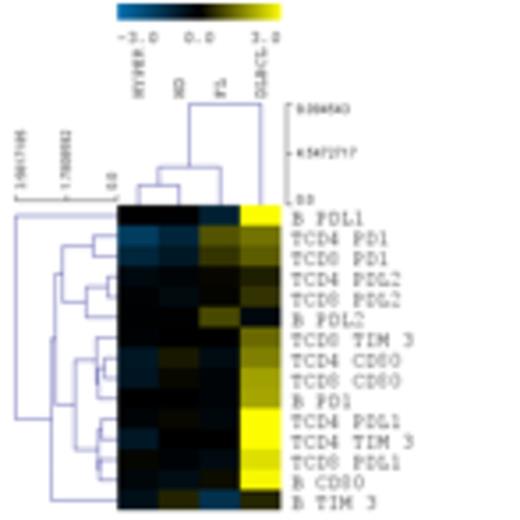Abstract
The regulation of immune response through cosignaling receptors is the major mechanism that prevent normal responses against peripheral tissues but that is used by tumor to hijack the autologous immune responses. This therapy are currently among the most promising adjuvant therapy in cancers including lymphomas. In addition sPDL1 is an important marker of patient's prognosis (Rossille et al., Leukemia 2014)
Our objective was the study of the expression of ligands by activating receptors on diffuse large B cell lymphoma (DLBCL) in comparison to Follicular Lymphoma (FL), Hodgkin Lymphoma (HL) and hyperplasia and to investigate the status of the infiltrating immune system as well as the function of the sorted autologous interaction of T cells against autologous DLBCL
Methods: We have dissociated fresh tumor B cell samples ( FL= 13, HD= 15, DLBCL = 15) and analysed the immune microenvironment and DLBCL by flow cytometry using mAbs recognizing cosignaling molecules of 15 samples. In a second step we have sorted the T cells and autologous DLBCL and performed cocultures with the coincubation with antagonist PD1 (PD1.3.1) PDL1 (PDL1.3.1) PDL2 (PDL2.1), Tim3 and CD80 mAbs. T cell stimulation was performed for 5 days. We have previously described the proprietary antagonist PD1, PDL1, PDL2 and CD80 used (Serriari et al., J. Immunol., 2010; Ghiotto et al. , Int.Immunol., 2010)
Results: The immune cells including T cells present within the DLBCL microenvironment are characterized by a highly activated /exhausted status as evidenced by the expression of PD-1, PDL1, PDL2, CD80 and Tim3 Figure 1) . Importantly most of these receptors are involved in negative signals provided their ligand is expressed on their cognate target cell. PDL1, PDL2 and CD80 are both present on DLBCL with some degree of heterogeneity among tumors and surprisingly PD1. Autologous T cell and lymphoma cells were sorted and autologous responses such as proliferation and cytokine production were analysed after in vitro culture without or with antagonist mAbs directed against cosignaling receptors. We could evidence for the first time to our knowledge that blockade of PD1 and CD80 pathways induced /restored the autologous response of infiltrating T cells.
Conclusions: These data demonstrate that a subgroup of DLBCL patients might benefit from treatment with checkpoint blockade mAbs. A major objective is to understand the molecular basis of DLBCL heterogeneity that currently investigated.
No relevant conflicts of interest to declare.
Author notes
Asterisk with author names denotes non-ASH members.


This feature is available to Subscribers Only
Sign In or Create an Account Close Modal